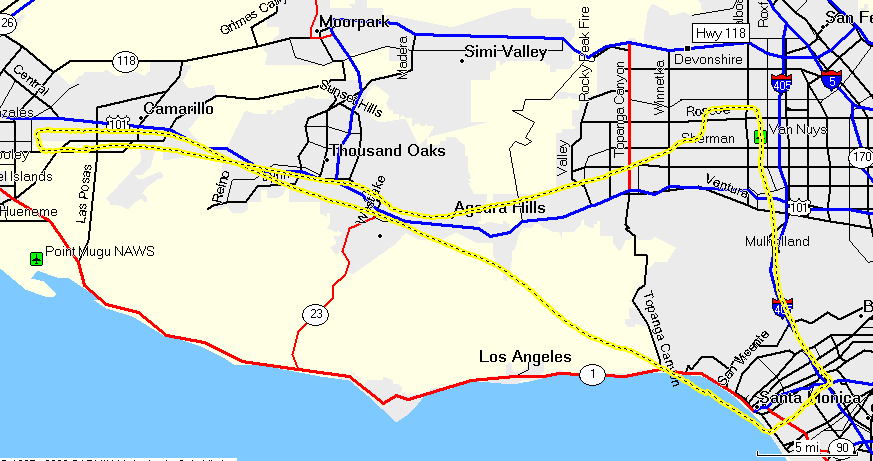Lesson 42 - Thursday July 22nd
Checkout Ride to CMA and VNY
Today Craig took me to Camarillo, and then to Van Nuys, so that he could extend my solo endorsement to include those two airports (instead of just Santa Monica).
Once again I stashed my GPS in the back of the plane.

We start off in Santa Monica, of course, that's about where the "M" is in Santa Monica, in the bottom right. The track proceeds roughly clockwise, over the bay, to Camarillo on the left, then Van Nuys on the upper right. The whole trip took less than an hour.
Since I'd been to CMA twice before, it was reasonably straightforward getting there. I knew all I had to do was fly over the Santa Monica Mountains until I got to the 101, follow that East until Thousand Oaks, call CMA there, and then begin the descent at around the Conejo grade (where the Santa Monica Mountains ends, and the flatness of the Camarillo and Oxnard begins.
And that's pretty much what I did. The climb over the mountains was uneventful, just get to 4500 feet, and keep it there. I messed up the radio call a bit when making first contact with CMA, as I said "Rodger, 48H", when I'd not really understood what they said. I should have just asked them to repeat. ("Say Again"). But Craig had caught what they said, just "report at five miles out".
So in we go, land for a touch and go, (about where the "101" sign is at Camarillo), reasonably straightforward. I'm not making the best landings ever, but I've not had anything particularly hard, or any bounces yet. I feel like I'm having trouble keeping lined up, but it's all seeming to work just fine. I've never initiated a go-around though, which makes me a little nervous.
Then we head for Van Nuys. Back along the freeway. Now this is a bit more complex, as I've only landed there once before, and then from the South. Here were approach from the west. I call at about the Warner center. It's a lot easier to make position reports relative to a landmark, I get confused trying to figure out "five miles south east". We get a squawk (a discreet transponder code that shows up on their radar, so they can identify us), and Craig asks them for a touch and go.
I had some trouble spotting the airport, it's a little hazy, and I can see something where it should be, but I'm not sure if it's VNY or if I'm looking too far and seeing Burbank. I look at the map, and think about turing in the VOR, but I lose focus a bit, and start gaining altitude, as my grip tightens on the yoke. By the time I've got things level again, it's apparent that what I see is actually VNY. I think I'd tune in the VOR if I were by myself.
Of course I could always use the GPS, but I'm supposed to be learning to navigate without one first, so I think that even on solo runs I'm just going to keep it in the bag, just to track my flights, and as an emergency backup, in case I get really lost. For a flight like this, I suppose I should be able to do it all through pilotage.
It must not be too busy today, we get cleared in fairly easily and slide in for a touch and go on runway 16R, the long one. Craig reminds me I should be entering downwind at 45 degrees, and we seem to be heading for base instead, hence the little wiggle you see on the line before turing base.
So we land, which, while nervous, was quite reasonable. I take off again, and head for home, reasonably straightforward again, get the SMO ATIS as we leave VNY class D, keep under the BUR class C at 2800 ft by keeping to 2500 ft, call SMO at about the Getty, get a "right base, report the VA", fly down, report the VA, get "follow a Cessna on a modified mile-and-a-half final", which we do, turning a bit wide, back on center, land.
Now that paragraph looks kind of complicated, but if you break it down it's pretty simple. Like most things that seem complicated, it's really just a lot of very simple things strung together. Once you get familiar with the individual things (like, keep under 2800 feet in this area), it's all pretty simple. It just takes a goodly amount of time, as the number of simple things is somewhat large.